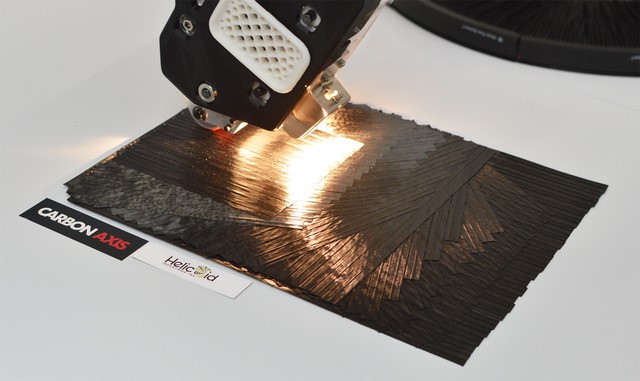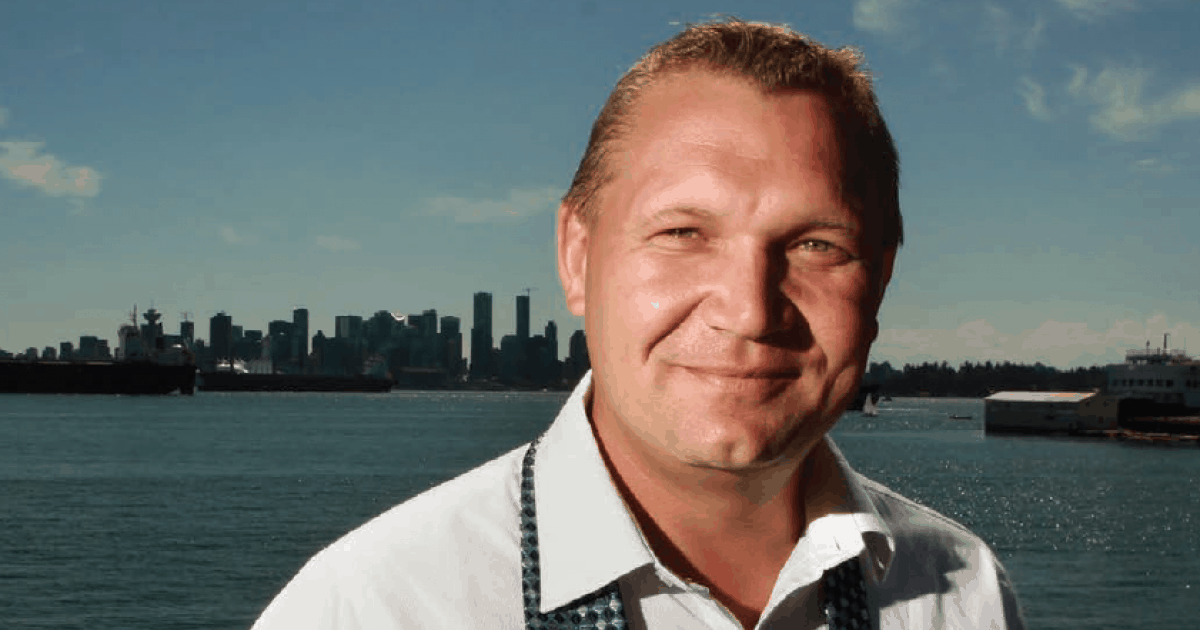Chad Wasilenkoff has an incredible track record of building companies and won a myriad of awards. His latest, Helicoid Industries, is in composite technology.
He has been named one of Vancouver’s top 40 under 40, RISI’s list of 50 Most Influential People in the Global Forest Industry, and won the hugely prestigious Ernst and Young Entrepreneur of the Year (Pacific region and Manufacturing Division). But structuring for composite materials is a whole new venture.
An extraordinary childhood
Chad loved to buy and sell things, even as a very young child. He liked the concept of making money and negotiated with his parents over doing chores. In Canada, the family lived near a golf course. Chad saw how many balls were hit into the lake there. It was the first of a lifetime spent spotting money-generating opportunities.
The lake yielded a never-ending quantity of golf balls, which Chad would then sell on. It wasn’t unusual for him to be making $1000 in a weekend, and soon he had other boys working for him.
It taught him that making money meant working hard, so when he wanted the 1st Atari video game, he asked his mother. She told him he would have to pay for it but introduced him to the classified ads. Intrigued, Chad shopped around and bought three, two to sell on.
He traded golf balls and video games, skateboards, and bikes. By his teens, Chad had progressed to cars, art, gold, and diamonds. Before long, the Head of his High School contacted his mother. Chad was missing around 90% of his classes and driving a Porsche 911. The school thought he must be dealing drugs till they found out the reality.
A glittering career
Chad started to buy shares and take minority stakes in businesses during his time at British Columbia University, and within a few years was purchasing whole companies. He also started his career as an investment advisor and headed up a group of private equity investors that bought Dynasty Metals and Mining for $1 million. When the price of gold rocketed from $300 to $700 an ounce, Dynasty’s market capitalization reached $250 million.
Chad then became CEO and director of Titan Uranium Exploration Inc., transforming a debt-ridden shell company into a market leader, not least from timing once again as the uranium market escalated rapidly.
His next venture was Fortress Paper. Fortress was founded in 2006 and acquired a Swiss-based banknote mill and a German wallpaper mill. Fortress’s wallpaper mill had one highly profitable line, but some loss-makers produced to keep customers on-side. Chad outsourced and white-labeled the loss-making items, which made them profitable. He then concentrated all the company’s activities on the line that was making money.
The company, bought for $5m, was suddenly delivering 20m in profits. The company subsequently sold to an NYSE-listed company for $210 million. Fortress Optical Features, was bought from the Bank of Canada to manufacture banknote threads for $750,000, sold three years later for $17.5 million Canadian.
Chad says that it is all about value creation. Chad observes that with many struggling companies, existing management teams concentrate on what is in front of them and think they have done well, achieving 1-2%. They don’t see the big picture opportunities.
Chad has worked in forestry, manufacturing, mining, gas, and various technology-based companies, both at start-up, turnaround, and rapid change. He has repeatedly produced above-average growth in these challenging industries, achieving year on year growth of revenue and profit.
Of the thirty companies he has grown, he has taken more than a dozen public, raising over $1 billion in the process.
Helicoid Industries.Inc and discovering Composites
Attracted to the sun, Chad moved to California. A friend of a friend asked him to help out in the universities locally, guest speaking and judging competitions. A few years in, Chad asked his contacts at the universities what business ideas were incubating with potential. They all agreed the one with the most potential was some technology for composite materials called Helicoid.
Chad knew nothing about composite materials and their construction use, so he flew down an expert from Seattle who worked for Boeing. The expert was so impressed that he is now the company’s Chief Technical Officer and took equity rather than a salary to join.
Chad formed Helicoid Industries Inc, based in Indio, California. The Helicoid™ technology was licensed to them by a consortium of California Universities in March 2019.
The Helicoid™ technology
Imagine something lightweight, resistant to impact, and inspired by a shrimp. Welcome to Helicoid composite technology and the world of biomimicry. Biomimicry is the design and production of materials, systems, and structures that emulate nature. Composite materials are the combination of any two materials with different physical and chemical properties.
Helicoid is a patented structure of unique toughness and strength, constructed from parallel fibrous layer stacks with inter-ply pitch angles. Biomimicry researchers at the UC Riverside campus had spent over a decade reverse engineering how the Mantis shrimp was so effective with the speed and force of its club acted as a hammer and smashed its prey. They found that it was not the strength of the material but the structure. The research involved collaboration with fourteen other universities and cost $12m.
When this structure is used with composite materials, the result is increased strength and durability. The composite structure can be substituted for wood, aluminum or steel at far less weight and cost. Companies making goods with composite laminates do not have to change materials but simply change the structure of how they are put together.
Wind farms, defense, aerospace, automotive, and sporting goods to a wide range of commercial, industrial, and consumer products can benefit from using composite materials with Helicoid structures. Any equipment needing lightweight, ill fatigue, energy dissipation is ideal.
One example they have been working with is the construction of hockey sticks. Using their structures with composite materials brings costs right down and increases the performance by between 25 and 75%. With wind turbines, they have achieved a 30% improvement.

The Helicoid journey so far
Having licensed the tech, he drew up a business plan and focussed on forming the right team. The applications for Helicoid with composites are so diverse, and the more sector-specific specialist they have, the more doors they can open. Each brings a strong Rolodex of contacts with them.
Initially, Chad had aspirations of getting into manufacturing. As soon as he saw how diverse the product was, he saw it didn’t make sense for them to be making tennis rackets alongside wind turbines. Better to let others do the manufacturing.
The cost savings they offer are so significant, around 20-25%, that they can afford to charge a 6% fee and there is still enough profit generated for everyone to benefit hugely. The companies already have the right machinery so they can put it to use straight away.
With experts on his team in the different sectors, they are in varying stages of discussions with leaders in many markets. Most potential customers want prototypes, and they have some 20 companies now doing these.
They offer the technology for structuring the composite materials either through strategic partners or under licensing opportunities but with the support and know-how their customers need to benefit from the products.
Chad’s other focus has been fundraising. He had planned to raise a $5m seed investment in total, and the first $2.8 came in fast in 2020, enabling him to leave it till recently to re-look at raising the remaining $2.2.m
The future for Chad and Helicoid
The goal with Helicoid is to go public. With his team, they will expand each sector they supply to, helping them adopt and implement the Helicoid tech.
The most significant opportunity of all for them is aerospace, and while they have the interest from Boeing, Airbus, and others, it will take at least ten years of testing before a deal can be in place. However, with rising fuel costs, all transport, both automotive and aerospace, need fuel efficiencies.
Chad and his team will continue to validate the product with other deals in myriad different industries so that when they float, the share price should reflect the aerospace opportunity. The aerospace industry accounts for over 50% of the composite materials markets.
At this point, Chad will probably pass the company on to others. He has another company, a world away from composite materials, in the medical devices section. Incredibly their tech is 70 years old. Chad hopes to launch that one and raise money for it later in 2021.
Chad’s motivation has always been to problem solve. He has retired a couple of times but gets too bored. Wherever he goes, even a restaurant, he thinks about how he could improve things. He does some mentoring for the same reasons but likes to find one or two impactful and big enough projects to fulfill him. At one point, he was CEO of five publicly listed companies at the same time. Two, he says, is a much slower pace.
Chad also assures me that a big deal is no more work than a minor deal, and raising large sums of money is considerably easier than raising small sums.
Chad’s advice to other entrepreneurs:
I asked him for his advice to other entrepreneurs gleaned from his colossal successes.
He says that you need to work harder in a start-up than anyone else. You need to know your subject and market the best you possibly can. Then, ensure you rely on others with more experience and knowledge who can give you good guidance.
Most start-ups fail because they run out of money. An experienced management team will help stop that from happening. Another advantage of an experienced team is that they will see nuances in the market that you may miss, and sometimes that means seeing that the project won’t work. Far better, if that is the case, to find out sooner than later.
Selecting the right top team always comes down to contacts and experience. If you are going into a brand-new industry, as Chad often has and indeed did with composite materials, your knowledge will never equate to twenty years in that industry. Bring in a team with that experience and expertise and then give them the freedom to achieve and incentivize with equity.
You want them to grow with the company. Chad believes in hiring slow and firing fast. He may give freedom, but he expects results. He allows a few errors, but especially a start-up cannot afford anyone who doesn’t carry their weight.
I was keen to hear his advice on attracting that world-class talent to a start-up team. Chad says it is much more challenging if you don’t already know the industry you are going into. Chad believes it to be crucial. People make the mistake of hiring their high school buddy or a member of the family. It hardly ever works. Bringing in global quality people will cost you less in the end.
Grabbing their interest will only happen if you think big. If you want to go into the restaurant trade, don’t talk about an idea for the perfect hamburger stall on the street corner. Talk about the fantastic concept you have had for a global chain of restaurants.
Some businesses are simply not meant to be big projects, and those won’t interest investors. There is nothing wrong with them at all. A corner store can be a great idea – just not for attracting global talent.



